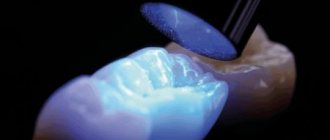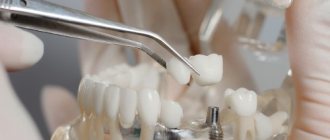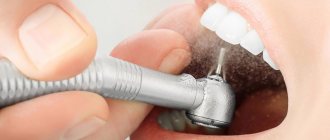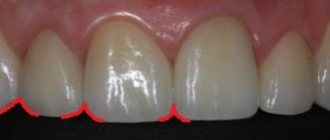Diana Levchuk. Founder and chief physician of aesthetic dentistry Deva-Dent. The doctor is an orthopedic dentist specializing in aesthetic treatment and prosthetics. Has 15 years of experience in therapeutic and orthopedic dentistry.
The reason for writing this article was a question that is often asked, especially from the regions of Russia:
“The clinic advised me to get a paid light filling, but how is it better than the usual free one?”
In such a situation, most patients agree to a “paid” or more expensive filling. However, having already agreed, such a patient has little idea what it is and what he has to overpay for. But the price of a light-curing filling can also be different and sometimes differ significantly!
Well, let’s try to “put everything into pieces.”
What is a light seal
It is no secret that Soviet dentistry was on the sidelines of world progress in its field of medicine. Today things are much better. If we talk about private dentistry, then everything is pretty good here (relative to the recent past).
State clinics that provide dental services have also updated their material and technical base. Despite this, you can often find “dinosaur doctors” there who, “at their age,” no longer want to learn new modern techniques and treat the old-fashioned way.
And the system of state dental clinics itself has not gone far, if we talk about the standards of services provided. Well, for example, in our country, canals are still treated with arsenic (it’s poison, if anything), and light-curing filling remains a VIP service =).
Remember! In modern adult dentistry, arsenic is not used, and only light-cured fillings are used!
A light-curing filling or photopolymer filling is a plastic material, the hardening of which occurs under the influence of a special polymerization lamp.
Even the simplest light filling has a tremendous advantage over a conventional filling (chemical curing). Among the advantages are: better fit (read to the end why this is needed), resistance to abrasion, and the ability to accurately adjust the shape of the tooth being restored, as a result - turnkey work in one visit.
Important! The key to a good and durable filling is not only the material, but also the quality of the treatment performed!
Yes, you can put a filling made of the most expensive material, but treat the tooth in such a way that within a year the tooth will have to be removed (this is, of course, necessary to try, but it happens).
Stages of installing a seal
Installing a light seal is a lengthy process, but the result is worth it. The patient receives not just a patch for the tooth, he receives an almost new tooth with artificial filling. This step does not include pain relief because it is only used when necessary.
- First, the dentist examines the damaged tooth, removes damaged tissue, and disinfects the internal and external surfaces of the tooth. If necessary, grinds a hole to the required diameter
- Once all the preparatory work has been completed, the doctor dries the surface of the tooth so that saliva does not remain under the layers of the filling.
- A light-sensitive polymer is placed into the resulting cavity layer by layer. Each layer is dried until hardened, after which a new one is applied
- The very last top layer requires special attention. The dentist’s task is to recreate the surface in such a way that the tooth is reconstructed to its original state
- Before exposing the final layer to ultraviolet light, the dentist checks the interaction of the tooth with the opposing teeth. The bite should not change
- After the filling has hardened under exposure to light, it is ground and polished to resemble a natural tooth.
- The final stage will be an x-ray of the tooth to make sure there is no air and moisture in the dental cavity. Typically, this service is paid additionally
How much does a filling actually cost?
But now you come to dentistry, and the doctor offers you a choice of several types of light fillings, of which the cheapest can cost (relatively) from 1,500 rubles, the middle price segment - about 3,000 and the most expensive - 5,000 or more... And which one to choose ?
In the dentist’s office there is hardly anyone to ask: the dentist and the clinic, of course, are interested in selling the most expensive product. And usually the patient has to rely on the integrity of the doctor and accept the choice that the dentist himself offers. We want to help you make an informed choice of filling that meets your needs and capabilities.
So, what does the cost of a filling consist of (in this article I consider only the filling, without taking into account the cost of root canal treatment):
1. Qualification: here we record annual additional professional training and courses (all doctors in our dentistry spend from 30,000 to 150,000 rubles for these purposes every year). You have to save from each filling =).
2. Equipment: standard equipment for a dental office to provide the usual range of services costs from 500,000 to 1,500,000, and this does not take into account the cost of equipment for the X-ray room and sterilization room. To place the most ordinary filling without pain and unnecessary injury, you need a high-speed, water-cooled installation.
3. Premises maintenance or operating expenses: this includes licensing, premises rental, insurance, cleaning, assistant, administrator. It is unlikely that it will be possible to calculate correctly, but in the case of our clinic, each patient’s appointment costs at least 1000 rubles, regardless of the service provided, even if it is just a consultation =). If you are from Moscow, then, by the way, you can sign up online.
4. To install a filling, you also need tools of limited use (short service life or disposable) - such as burs, rubber bands, grinding discs, strips, brushes, wedges, matrices, etc. Yes, these “small things” also add up to a decent amount .
5. Cost of a filling : “Well, finally!”, you say. But it’s not that simple... Before announcing the nominal cost of a filling (filling material), I urge you to review the points above again: without them, this price in no way reflects the cost of the work to install the filling. It is also obvious that the amount of material required to treat a particular tooth is always individual. So, we have an aesthetic dentistry clinic and we use only materials in the “above average and premium” price segment. The material that we usually use for the restoration of chewing teeth costs about 5,000 rubles per syringe (about 10 fillings).
It would seem that what prevents you from putting a cheap filling on an expensive material if it is so inexpensive in itself? Probably nothing. Only I don’t know of such examples.
If dentistry or a dentist, or a clinic saves on good equipment, quality of repairs, advanced training and tools, do you really think that they will choose expensive material for you?
Buying expensive filling material yourself is also not an option. Each material has its own properties and you need experience in its use, or advanced training courses, to get high-quality work.
But if the doctor offers several options for fillings to choose from, it is worth choosing, of course, in favor of the more expensive material.
The most modern dental treatment has become free for Russians
A person who needs dental fillings has every right to free installation of light-curing fillings
Photo: Oleg GOLD
“KP” has repeatedly talked about the “secret” capabilities of the compulsory medical insurance policy, namely, the useful rights of patients, which most of us are not even aware of. Including - about free dentistry under the compulsory medical insurance policy: how to treat your teeth efficiently and not go broke. Our main consultant was one of the leading Russian specialists in healthcare, patients’ rights and the compulsory medical insurance system - the head of the National Agency for Patient Safety and Independent Medical Expertise, Doctor of Medical Sciences, expert of the All-Russian Union of Insurers Alexey Starchenko.
“YOU HAVE TO PAY FOR LIGHT CURING FILLINGS”
Often, when we look into the office of a dentist at a district clinic, we hear: if you want anesthesia and materials for fillings for free, then they will, to put it mildly, not be the best. It seems logical: we always don’t have enough money for healthcare, so we buy whatever is cheaper for state and municipal hospitals. And if a patient wants modern light-curing fillings, then, as a rule, he receives the answer: this material does not even fit into compulsory medical insurance, and you definitely have to pay for it!
“This situation is actually misleading the consumer of medical services, that is, the patient,” emphasizes Alexey Starchenko. — Because the tariff at which clinics and hospitals receive payment for medical care provided includes the cost of consumables. And - attention! — today, not a single state guarantee program (a document on the provision of free medical care to Russian citizens. - Author) approved by the government contains restrictions on the types and costs of consumables. This means: the patient must be provided with what he needs for medical reasons and based on modern standards of treatment.
REGIONS GO TO FAILURE
In short, a person who needs dental fillings has every right to free installation of light-curing fillings, the expert said.
“I have been seeking an official response from the Ministry of Health on this topic for almost six months and I want to publish it through KP so that everyone knows,” said Alexey Starchenko back in the middle of last year. — The bottom line is that the government of the Russian Federation approves the basic compulsory medical insurance program, which lists, among other things, dental diseases - caries, pulpitis and others. That is, those diseases that require filling. In this state guarantee program, as confirmed by the Ministry of Health, no consumables are limited. That is, everything that is provided for by modern standards of treatment, without restrictions, should be provided to the patient free of charge. If a person needs a light-curing filling, it must be included in the territorial compulsory medical insurance program of the region where the patient lives and paid for using compulsory medical insurance funds.
After Komsomolskaya Pravda published an article about this, we received complaints. Readers from different regions of Russia - both patients and doctors, including the chief doctors of some hospitals - reported that local compulsory medical insurance programs do not include any light-curing fillings, and therefore they cannot be given to people for free.
COURTS ARE CANCELED!
One of the KP readers, Oleg L. from Saratov, on the advice of our expert Alexey Starchenko, decided to defend his rights and sent the indicated links to legislation and the official response of the Ministry of Health to his regional health authorities and the Compulsory Medical Insurance Fund. And replies came from everywhere: they say, our documents do not say verbatim that compulsory medical insurance includes light-curing fillings, so you are not required to have them.
- This is, of course, a violation, since, I repeat once again, federal legislation prescribes the use of what the patient requires, including modern materials - in other words, the principle “everything that is not prohibited is permitted” (and necessary for medical reasons, of course) applies. explains lawyer Starchenko. — If local authorities do not cooperate, it is necessary to go to court.
However, the courts are a long and troublesome process. While a KP reader from Saratov was collecting documentation, great news came.
— After our joint bombardment of various authorities, the Ministry of Health and the Federal Compulsory Medical Insurance Fund (FFOMS) released a document that directly, verbatim, speaks of the inclusion of photopolymer fillings (that is, those same light-curing fillings) in the basic compulsory medical insurance program, operating in all regions of Russia without exception, - emphasizes Alexey Starchenko. “Now people can refer to these specific recommendations (see below), and in most cases, there will likely be no need to fight for their rights in court.
OFFICIALLY
What are dental patients entitled to under compulsory medical insurance policies?
Restoring a tooth with a filling of class I - VI according to Black using materials from photopolymers, including polishing the filling.
What documents guarantee
— Program of state guarantees of free medical care to citizens for 2022 and for the planning period of 2018 and 2022 (Resolution of the Government of the Russian Federation of December 19, 2016 No. 1403);
— Methodological recommendations on methods of paying for medical care using compulsory health insurance funds, Appendix 7 (letter of the Ministry of Health of Russia N 11-7/10/2-8080 and the Federal Compulsory Medical Insurance Fund N 13572/26-2/i dated November 21, 2017) .
EXPERT ADVICE
If in the dental clinic where you went under the compulsory medical insurance policy, they tell you that there is another anesthesia, consumables, and they are definitely better, but are used only for a fee, then you need to immediately call your insurance company that issued the compulsory medical insurance policy (telephone often indicated on the policy or you can find it out on the Internet), advises the head of the National Agency for Patient Safety and Independent Medical Expertise. According to the law, health insurers now act as free advocates for patients, advise on all issues, help protect the right to high-quality free medical care and, among other things, have the right to fine clinics for violating the legitimate interests of citizens.
What materials are used for such filling?
Let's consider all the options for filling materials that are used in Clarimed dentistry. They have proven to be the best in terms of price-quality ratio and help solve almost any problem with chewing teeth.
Glass ionomer cement (GIC). This is a modern cement material that is often used to install permanent fillings on the chewing surface. It hardens well in a humid environment, so it is also used to treat the most problematic types of caries, for example, those below the gum level. The material creates intermolecular bonds with enamel and dentin, therefore it holds well and does not require additional sites for strengthening. During the polymerization process, the cement material practically does not shrink, releases fluoride ions into the tooth tissue and adheres perfectly to the edge of enamel and dentin due to thermal expansion.
Make an appointment
Light-curing composite "Filtek". A light-curing nanocomposite material that has received medals in various dental competitions at the international level for several years in a row. It lends itself well to modeling, is aesthetic, elastic and very durable after hardening. Suitable for any carious cavities, retains its properties for a long time and is minimally susceptible to abrasion.
Liquid-flowing light-curing composite FLOW. Ideal for filling small carious cavities on chewing teeth. The material is aesthetic, well modeled, and durable.
Liquid-flowing light-curing composite Estelite. The highest award in the field of dental restoration, a kind of dental Oscar, according to the popular American magazine The Dental Advisor, was awarded to this Japanese filling material from 2010 to 2022.
Estelite is suitable for all types of carious cavities, gives minimal shrinkage when cured and has 20 shades that will completely restore the aesthetics of any tooth. This is the most wear-resistant material presented, it has minimal abrasion, and it is possible to restore both front and side teeth; cutting and chewing surfaces. The Japanese composition releases fluoride ions, therefore reducing the risk of recurrent caries. In addition, the composite is characterized by deep adhesion to dentin, resulting in a monolithic structure without a marginal gap.
If the filling is placed correctly on the chewing surface, then it is practically indistinguishable from a real tooth.
What types of fillings are better?
Many dentists recommend installing fillings made of light-curing composite. They are characterized by increased strength and durability, and look natural. Composite fillings are suitable for filling cavities in distant teeth and restoring carious cavities, as well as for treating erosions of hard tissues. Their service life is 5 years.
Glass ionomer cement, which is a hybrid of acrylic and silicate components, is also considered a good choice for filling. Glass ionomer combines well with natural coatings and other established types of fillings; it is suitable for treating destructive processes of the tooth, filling the anatomical space under the roots, and preparing the cavity for further orthopedic manipulations.
Rules for caring for fillings
Despite the fact that many fillings can theoretically last for years, it is recommended to change the materials every 10-12 years. It is recommended to visit a doctor once every six months for hygiene measures. You should also make an appointment with a doctor if:
- short-term pain in the treated area;
- detection of cracks;
- presence of a chip in the filling material.
The dentist can easily replace a bad filling with a new one.
If there is a large amount of restoration material in the cavity, you can ask the specialist to prescribe a gel with a high fluoride content. Its regular application will help strengthen the hard surface and prevent caries from forming again. Filled teeth may also be coated with fluoride varnish during the examination.
At home, it is recommended to use mouth rinses. With their help, you can significantly reduce the number of microbes that cause caries.
Summarizing the above, I would like to note that filling is a serious procedure. To prevent dental treatment under anesthesia from ending with repeated fillings and a double waste of time and money, you should seek help only from reliable, experienced specialists.
Preparatory measures
First, the dentist will have to visually examine the defect in the front tooth. If your teeth have decay, you may need to take x-rays. In particularly difficult cases, the nerve may need to be removed. Of course, this happens under the influence of a high-quality anesthetic.
If there is no caries, and the reason for the visit to the dentist is a chipped front unit, then the enamel is cleaned of plaque and tartar is removed. Next comes the filling process itself.











